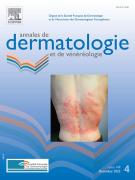Autohémothérapie locale dans l'angiodermite nécrotique : étude pilote - 29/04/08
D. Courivaud [1],
M. Ségard [1],
S. Darras [1],
O. Carpentier [1],
P. Thomas [1]
Voir les affiliations| pages | 5 |
| Iconographies | 7 |
| Vidéos | 0 |
| Autres | 0 |
Introduction |
L'angiodermite nécrotique est une variété d'ulcère de jambe, caractérisée par son caractère très algique et rapidement extensif. La cicatrisation est longue, en moyenne 4 à 11 mois. Le traitement est actuellement peu satisfaisant et difficile. Seule la réalisation de greffes cutanées précoces permettrait une sédation rapide des douleurs et d'interrompre l'extension de la lésion. Cependant cette technique, réalisée en phase évolutive, expose à un certain nombre de greffes perdues. Nous avons voulu confirmer l'efficacité de l'autohémothérapie locale proposée dans 2 études non controlées.
Malades et méthode |
Onze malades, ayant une angiodermite nécrotique, ont été inclus dans une étude prospective, non contrôlée. L'autohémothérapie locale était réalisée trois fois par semaine pendant un mois avec une hospitalisation initiale de quinze jours. Les critères d'évaluation étaient : l'évolution de la douleur, de la surface de l'ulcère, de l'échelle colorimétrique et le délai de disparition du halo violacé.
Résultats |
Dix malades ont été soulagés par le traitement, avec un sevrage progressif en antalgiques. Un arrêt de l'évolution avec disparition du halo violacé périphérique a été noté en moyenne à J6 (2-21j). Le pourcentage de tissu de granulation par rapport à la surface de l'ulcère représentait 45,4 p. 100 à J0, 80 p. 100 à J14 et 85 p. 100 à J28.
Conclusion |
L'autohémothérapie utilisée à la phase initiale du traitement permet de diminuer les douleurs et de préparer la lésion à une greffe secondaire de recouvrement.
Topical haemotherapy as treatment for necrotic angiodermatitis: a pilot study. |
Introduction |
Necrotic angiodermatitis is a variety of leg ulcer, characterized by very painful and rapidly spreading lesions. Healing takes time, a mean of 4 to 11 months. Current treatment is difficult and rarely satisfactory. Only early skin grafts lead to rapid sedation of pain and stop the lesion from extending. However, this technique, performed during a progressive phase, enhances the risk of losing a certain number of grafts. We wanted to confirm the efficacy of local auto-haemo-therapy proposed in 2 non-controlled studies.
Patients and methods |
Eleven patients with necrotic angiodermatitis were included in our non-controlled prospective study. The topical hemotherapy was applied three times a week for one month, with initial hospitalization for 15 days. The criteria of assessment were: evolution of pain, surface of the ulcer, colorimetric scale and the date of disappearance of the purple halo.
Results |
Ten patients were relieved by the treatment, with progressive withdrawal of the analgesics. The progression of the lesion had stopped and the purple halo had disappeared in general by D6 (range: 2 to 21 days). The percentage of granulation tissue with regard to the surface of the ulcer was of 45.4 p. 100 on D0, 80 p. 100 on D14 and 85 p. 100 on D28.
Conclusion |
Topical hemotherapy applied during the initial phase of treatment would reduce the pain and prepare the lesion for a secondary skin graft.
Plan
© 2005 Elsevier Masson SAS. Tous droits réservés.
Vol 132 - N° 3
P. 225-229 - mars 2005 Retour au numéroBienvenue sur EM-consulte, la référence des professionnels de santé.
L’accès au texte intégral de cet article nécessite un abonnement.
Bienvenue sur EM-consulte, la référence des professionnels de santé.
L’achat d’article à l’unité est indisponible à l’heure actuelle.
Déjà abonné à cette revue ?

